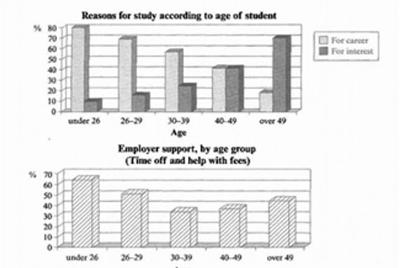Task 1 IELTS Sample:
Reasons for study and employer support
by dravid
(thailand )

The charts show the main reasons for study among students of different age groups and the amount of support they received from employers.
The bar chart illustrates the reasons why people study and the second chart shows the level of support given by their employer according to different age group
Overall, it can be seen that more people are keen on studying to building their careers, even though it tends to decline as they grow up. It can be also seen that employers support is maximum for those who are under 29.
Moving on to the next chart, it is crystal clear that employer support is very high when people are above 26 years of age. Unfortunately, this figure drops to 50% for the ages (26-29) and finally little over 30%(30-39). However, there is tendency to increase in receiving employers’ support for the next two age profiles.
==================================================
IELTS buddy
Feedback
Corrected Version:
The first bar chart illustrates the reasons why people study and the second chart shows the level of support given by their employer according to different age groups.
Overall, it can be seen that more people are keen on studying to
Moving on to the next chart, it is
Overall it's a good answer as your response is easy to follow and you decribe and contrast the key data. You also have some good complex sentences in there. Just a few things to note:
Look at the data on the graph carefully - you make a few mistakes with incorrect data taken from the graph. This may affect your score.
crystal clear = this is too informal for academic writing
Careful how you use brackets:
dropping to 70% for the ages ( 26-29), 40% for the ages (40 -49),
Unfortunately, this figure drops to 50% for the ages (26-29) and finally a little over 30% (30-39).
These need to be a part of the sentence.
Try to vary your language - you say 'drop' three times, which is why I changed one to 'fall'
Comments for Task 1 IELTS Sample:
|
||
|
||
|
||
|
||